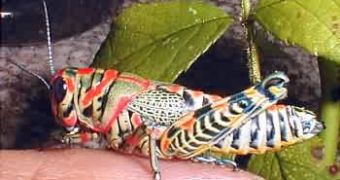These legs are made for jumping.
American researchers have put recently 20 grasshopper species to a jumping test and compared them to hopping humans. "[The grasshopper muscle] is the only invertebrate muscle that functions like our sprinting muscle," said Scott Kirkton of Union College in New York. Only that, according to our body length, we should jump up to 90 feet (30 m).
Grasshoppers grow in wingless stages named instars, and they molt gradually, growing until they reach the adult phase. The juveniles rely on speedy jumps to escape predators and seem to posses a never-ending energy supply as they do not get tired: they jump restlessly. The adults use a powerful sole jump to launch into the air to fly. These rapid energy bursts are similar to those encountered in human sprinting muscles and are anaerobic (non-oxygen) processes.
But the lactic acid that forms during the anaerobic burning causes muscle soreness. We, humans, cannot tolerate the accumulation of too much lactic acid in our muscles, that's why we get muscle fatigue or muscle sore. When the lactic acid has accumulated, our muscles simply can no longer function. "So they go from being these little grasshoppers that can jump and jump without fatiguing to becoming older, and every time they molt, they fatigue more as they jump and they produce more lactate," Kirkton told LiveScience.
The 20 species investigated by Kirkton weighed from about 0.2 to 7 grams. Surprisingly, all the species jumped on average the same distance, about 38 inches (95 cm), no matter the size. Moreover, the grasshoppers had no similar ratio of muscle related to body mass. "It turns out the little ones have more muscle than you'd expect, so they should be doing better," Kirkton said.
In smaller species the jumping muscle was 6 % of the body mass compared to 1% for the biggest ones. The small species were also longer legged. "If you have a longer limb, you have a longer lever to accelerate," Kirkton said. "The puzzle can be solved by thinking about drag. Even though the smaller grasshoppers were equipped with longer, more muscle-packed legs, they have a tougher time contending with oncoming air molecules than bigger-bodied hoppers. Similarly, for instance, an ant would struggle to push through a puddle of water while a puppy would just scamper through", said Kirkton.
That's why small grasshoppers' muscles burn more energy on the anaerobic process, producing more toxic lactate. The smaller grasshoppers displayed 85 % more lactate in their jumping muscles than larger ones did. "This is the only insect muscle we know of that produces lactate during exercise," said Kirkton, who wants to tackle human medical issues related to muscle performance based on his researches.

 14 DAY TRIAL //
14 DAY TRIAL //